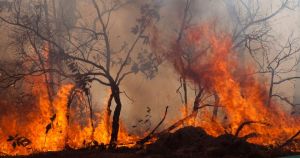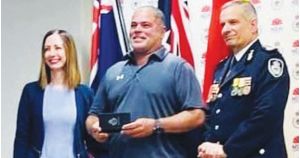
On Saturday 25th March 2023 at the historic former Wesleyan Chapel built in 1855 located in Gunderman, 54 people attended the Dharug and Lower Hawkesbury Historical Society’s 40th Anniversary. We were fortunate to welcome our inaugural President Lorraine Banks (who drove up from Canberra) and had the well wishes of Heather Winch, one of the founders of the Society. Also in attendance were previous Presidents of the Society, members from the Dural and Districts Historical Society, the Convict Trial Project and the Hornsby Shire Historical Society.
The name of the Society was chosen at the first meeting in March 1983. The initial assumption was to be the called Wisemans Ferry and Districts Historical Society, but as most people present lived on the north side of the River and as it was believed the Dharug people lived in the area, the original members wanted the historical Society to encompass the first occupants as well as the history of our European settlers so they agreed to be called the Dharug and Lower Hawkesbury Historical Society.
As befitting such an auspicious day we welcomed emeritus Dr Grace Karskens as our guest speaker. Grace has been involved in researching and exploring the Hawkesbury and environs for many years from her earlier work on the history of the Great North Road and its convict builders to the secret history of Dyarubbin, the Hawkesbury-Nepean River which is the subject of her highly acclaimed publication People of the River Lost Worlds of early Australia. Grace explained this book examines early settler history and the great experiment of settlement, aboriginal history, environmental and flood history and the interactions of all of them.

Grace described her study of the river as a humbling but evolving journey in which she was helped by a group of Darug women. The chance discovery of Rev. John McGarvie’s list of over 170 Aboriginal place names in geographical order along the Hawkesbury and Macdonald rivers which he documented in 1829 has given rise for further research. The Real Secret River: Dyarubbin became a collaborative project that drew together Darug knowledge holders, artists and educators with historians, linguists and archaeologists to reconnect the names McGarvie collected back to their river places.
These place names list culturally significant locations each name holding a spiritual meaning for Aboriginal people despite many of these indigenous names being forgotten after colonisation. Each name would describe the geography, or landmark or even a cultural event. Wisemans Ferry was called Woolloomoorang and Sackville was called Dorumbolooa which means ‘rainbow moves through’.
Of the 170 Aboriginal place names the Darug women have sourced over 90 of the names and it seems there was a whole country of Aboriginal names hidden (or lost) beneath the place names given by white settlers. This work is still ongoing.
A sumptuous afternoon tea followed to celebrate the 40th Anniversary in the function centre of our wonderful neighbours, Primrose and Roy Fox at the Missions. Many stories were shared and a glass was raised as the Anniversary cake was cut by Lorraine. Many thanks to all who joined us and in particular our guest speaker, Dr Grace Karskens.





